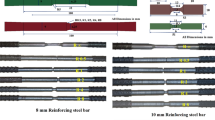Abstract
A component method has been introduced by Steel Construction Institute to predict the moment resistance of partial strength connection. The design philosophy is taken directly from Eurocode 3 with strength checks on bolts, welds, and steel which have been modified to comply with BS 5950-1:2000. The accuracy of the method however needs to be validated with the experimental tests especially for hot-rolled sections other than typical British Section (BS). Six experimental tests on beam-to-column connections have been carried out for Flush End-Plate (FEP) connections consisting of variable parameters such as thickness of end-plate, size and number of bolts, size of columns, and beams. The tests were set-up using local hot-rolled steel sections known as Perwaja Section (PS) for beams and columns instead of typical British Section (BS). The strength of materials for end-plate, column and beam sections were tested for tensile strength and used in predicting the moment resistance for component method. The moment versus rotation of the test results were plotted and compared with the moment resistance derived from component method. The study concluded that the moment resistance of the tested flush end-plate connections was higher than the predicted moment resistance from component method which showed good agreement between the two moments. The study also concluded that the tested FEP connections met the requirements and criteria of partial strength connections.
Similar content being viewed by others
References
Abdalla, K. M., Abu-Farsakh, G. A. R., and Barakat, S. A. (2007). “Experimental investigation of force-distribution in high-strength bolts in extended end-plate connections.” Steel and Composite Structures, SCS, 7(2), pp. 87–103.
Abdalla, K. M. and Chen, W. F. (1995) “Expanded Database of Semi-Rigid Steel Connections.” Computer and Structures, 56(4), pp. 553–564.
Al-Jabri, K. S., Burgess, I. W., Lennon, T., and Plank, R. J. (2005). “Moment Rotation-Temperature Curves for Semi- Rigid Joints.” Journal of Constructional Steel Research, 61, pp. 281–303.
Allen et al., Steel Construction Institute and British Constructional Steelwork Association Limited. (1995). Joints in Steel Construction. Volume 1: Moment Connections. Ascot, Berks: Steel Construction Institute.
Bose, B. (1993). “Tests to verify the performance of standard ductile connections.” Dundee Institute of Technology.
British Standards Institute BS 5950-1. (2000) Structural Use of Steelwork in Building Part 1: Code of Practice for Design-Rolled and Welded Sections. London: British Standards Institution.
British Standards Institute BS EN 10113. (1993). Hot rolled products in weldable fine grain structural steels. London: British Standards Institution.
Chen, W. F. (ed.) (1993). Semi-rigid Connections in Steel Frames-Council on tall Buildings and Urban Habitat. New York: Mc Graw-Hill.
Chen, W. F. and Kishi, N. (1989). “Semi-rigid Steel Beam- to-Column Connections: Database and Modelling.” Journal of Structural Engineering, 115(1), pp. 105–119.
Coelho, A. M. G, Bijlaard F. S. K., and Silva, L. S. D. (2004). “Experiemental assessment of the ductility of extended end-plate connections.” Journal of Enginering Structures, 26(9), pp. 1185–1206.
Couchman, G.H. (1997). Design of Semi-Continuous Braced Frames. Ascot, Berks: Steel Construction Institute.
Eurocode 3: EN 1993-1-1. (2005), Design of Steel Structures: General Rules and Rules for Buildings. Brussels: British Standards Institution.
Hussein, M. A. (2001). “Performance of connections on Major Axis using Local Sections”. M.Phil. Thesis, Universiti Teknologi Malaysia, Malaysia.
Jones, S. W., Kirby, P. A., and Nethercot, D. A. (1983). “The Analysis of Frames with Semi-Rigid Connections-A State of the Art Report.” Journal of Constructional Steel Research, 3(2), pp. 2–13.
Mahmood, Md. T., Hussein, A. M. (2008). “Experimental Tests on Extended End-Plate Connections with Variable Parameters.” International Journal of Steel Structures, 8(4), pp. 369–381.
Nethercot, D. and Zandonini, R. (1989). “Methods of Prediction of Joint Behaviour”. In: Narayanan, R. (ed). Structural Connections-Stability and Strength. Essex: Elsevier Applied Science, pp. 23–62.
Sayed-Ahmed, E. Y. (2007). “Design aspects of steel I-girders with corrugated steel webs.” Electronic Journal of Structural Engineering, EJSE, 7, pp. 27–40.
Shi, W. L., Li, G Q., Ye, Z. M., and Xiao, R. Y. (2007). “Cyclic Loading Tests on Composite Joints with Flush End Plate Connections.” International Journal of Steel Structures, 7, pp. 119–128.
Sulaiman, A. (2007). “Behaviour of partial-strength connection in semi-continuous construction for multistorey braced steel frame using TWP sections.” PhD Thesis. Universiti Teknologi Malaysia, Malaysia.
Tahir, M. M. (1997). “Structural and Economic Aspects of the Use of Semi-Rigid Joints in Steel Frames”. PhD Thesis. University of Warwick, UK.
Tahir, M. Md., Sulaiman, A., and Anis, S. (2008). “Experimental Tests on Composite and Non-Composite Connections Using Trapezoid Web Profiled Steel Sections.” International Journal of Steel Structures, 8(1), pp. 43–58.
Tahir, Sulaiman, and Saggaff, “Structural Behaviour of Trapezoidal Web Profiled Steel Beam Section Using Partial Strength Connection.” Electronic Journal of Structural Engineering, 8, pp. 55–66.
Weynand, K., Jaspart, J. P., and Steenhuis, M. (1998). “Economy Studies of Steel Frames with Semi-Rigid Joints.” Journal of Constructional Steel Research, 46(1–3), Paper No. 63.
Author information
Authors and Affiliations
Corresponding author
Rights and permissions
About this article
Cite this article
Tahir, M.M., Hussein, M.A., Sulaiman, A. et al. Comparison of component method with experimental tests for flush end-plate connections using hot-rolled perwaja steel sections. Int J Steel Struct 9, 161–174 (2009). https://doi.org/10.1007/BF03249491
Received:
Accepted:
Issue Date:
DOI: https://doi.org/10.1007/BF03249491




